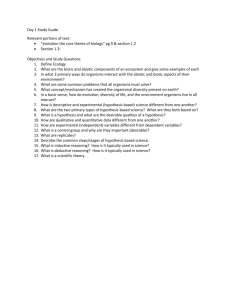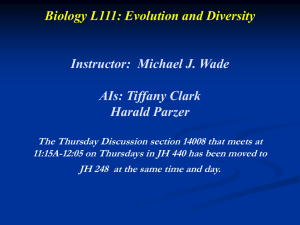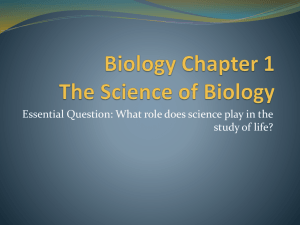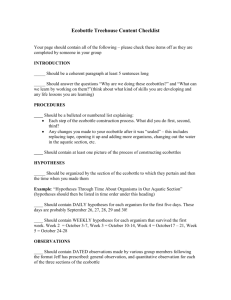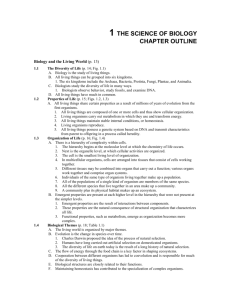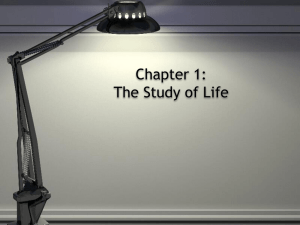Chapter 1 Notes
advertisement
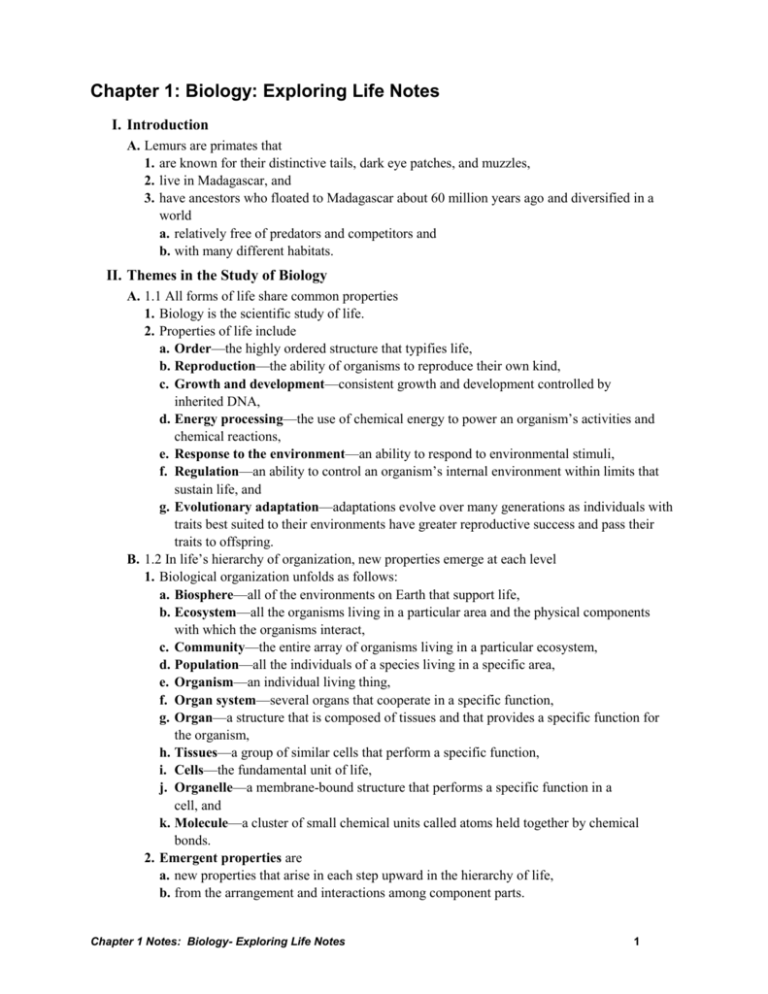
Chapter 1: Biology: Exploring Life Notes I. Introduction A. Lemurs are primates that 1. are known for their distinctive tails, dark eye patches, and muzzles, 2. live in Madagascar, and 3. have ancestors who floated to Madagascar about 60 million years ago and diversified in a world a. relatively free of predators and competitors and b. with many different habitats. II. Themes in the Study of Biology A. 1.1 All forms of life share common properties 1. Biology is the scientific study of life. 2. Properties of life include a. Order—the highly ordered structure that typifies life, b. Reproduction—the ability of organisms to reproduce their own kind, c. Growth and development—consistent growth and development controlled by inherited DNA, d. Energy processing—the use of chemical energy to power an organism’s activities and chemical reactions, e. Response to the environment—an ability to respond to environmental stimuli, f. Regulation—an ability to control an organism’s internal environment within limits that sustain life, and g. Evolutionary adaptation—adaptations evolve over many generations as individuals with traits best suited to their environments have greater reproductive success and pass their traits to offspring. B. 1.2 In life’s hierarchy of organization, new properties emerge at each level 1. Biological organization unfolds as follows: a. Biosphere—all of the environments on Earth that support life, b. Ecosystem—all the organisms living in a particular area and the physical components with which the organisms interact, c. Community—the entire array of organisms living in a particular ecosystem, d. Population—all the individuals of a species living in a specific area, e. Organism—an individual living thing, f. Organ system—several organs that cooperate in a specific function, g. Organ—a structure that is composed of tissues and that provides a specific function for the organism, h. Tissues—a group of similar cells that perform a specific function, i. Cells—the fundamental unit of life, j. Organelle—a membrane-bound structure that performs a specific function in a cell, and k. Molecule—a cluster of small chemical units called atoms held together by chemical bonds. 2. Emergent properties are a. new properties that arise in each step upward in the hierarchy of life, b. from the arrangement and interactions among component parts. Chapter 1 Notes: Biology- Exploring Life Notes 1 C. 1.3 Cells are the structural and functional units of life 1. Cells are the level at which the properties of life emerge. 2. A cell can a. regulate its internal environment, b. take in and use energy, c. respond to its environment, d. develop and maintain its complex organization, and e. give rise to new cells. 3. All cells a. are enclosed by a membrane that regulates the passage of materials between the cell and its surroundings and b. use DNA as their genetic information. 4. Cells illustrate another theme in biology: the correlation of structure and function. 5. Structure is related to function at all levels of biological organization. D. 1.4 Living organisms interact with their environment, exchanging matter and energy 1. Living organisms interact with their environments, which include a. other organisms and b. physical factors. 2. In most ecosystems a. plants are the producers that provide the food, b. consumers eat plants and other animals, and c. decomposers act as recyclers, changing complex matter into simpler mineral nutrients. 3. The dynamics of ecosystems include two major processes: a. The recycling of chemical nutrients from the atmosphere and soil through producers, consumers, and decomposers back to the environment. b. The one-way flow of energy through an ecosystem, entering as sunlight, converted to chemical energy by producers, passed on to consumers, and exiting as heat. III. The Process of Science A. 1.8 Scientific inquiry is used to ask and answer questions about nature 1. The word science is derived from a Latin verb meaning “to know.” Science is a way of knowing. 2. Scientists a. use inductive reasoning to draw general conclusions from many observations and b. deductive reasoning to come up with ways to test a hypothesis, a proposed explanation for a set of observations. The logic flows from general premises to the specific results we should expect if the premises are true. 3. How is a theory different from a hypothesis? A scientific theory is a. much broader in scope than a hypothesis, b. usually general enough to generate many new, specific hypotheses, which can then be tested, and c. supported by a large and usually growing body of evidence. 2 B. 1.9 Scientists form and test hypotheses and share their results 1. We solve everyday problems by using hypotheses. a. A common example would be the reasoning we use to answer the question, “Why doesn’t a flashlight work?” b. Using deductive reasoning we realize that the problem is either (1) the bulb or (2) the batteries. c. Further, a hypothesis must be i. testable and ii. falsifiable. d. In this example, two hypotheses are tested. 2. An actual research project demonstrates the process of science. 3. Scientists began with a set of observations and generalizations that a. poisonous animals are brightly colored and b. imposters resemble poisonous species but are actually harmless. 4. They then tested the hypothesis that mimics benefit because predators confuse them with the harmful species. 5. The scientists conducted a controlled experiment, comparing a. an experimental group consisting of artificial king snakes and b. a control group consisting of artificial brown snakes. c. The groups differed only by one factor, the coloration of the artificial snakes. d. The data fit the key prediction of the mimicry hypothesis. 6. Science is a social activity with most scientists working in teams. 7. Scientists share information in many ways. 8. Science seeks natural causes for natural phenomena. a. The scope of science is limited to the study of structures and processes that we can directly observe and measure. b. Hypotheses about supernatural forces or explanations are outside the bounds of science because they generate hypotheses that cannot be tested by science. Chapter 1: Biology – Exploring Life Word Parts bio- = life -logy = the scientific study of a subject tech- = skill or art -ell = small Vocabulary 1. biosphere- The entire portion of Earth inhabited by life; the sum of all the planet's ecosystems. 2. ecosystem- All the organisms in a given area, along with the nonliving (abiotic) factors with which they interact; a biological community and its physical environment. 3. community- An assemblage of all the organisms living together and potentially interacting in a particular area. 3 4. population- A group of individuals belonging to one species and living in the same geographic area. 5. organism- An individual living thing, such as a bacterium, fungus, protist, plant, or animal. 6. organ- A structure consisting of several tissues adapted as a group to perform specific functions. 7. organ system- A group of organs that work together in performing vital body functions. 8. tissue- An integrated group of cells with a common function, structure, or both. 9. cell- A basic unit of living matter separated from its environment by a plasma membrane; the fundamental structural unit of life. 10. organelle- A membrane-enclosed structure with a specialized function within a cell. 11. molecule- A group of two or more atoms held together by covalent bonds. 12. producer- An organism that makes organic food molecules from CO2, H2O, and other inoganic raw materials: a plant, alga, or autotrophic bacterium. 13. consumer- An organism that requires energy from eating plants or animals 14. decomposer- Prokaryotes and fungi that secrete enzymes that digest nutrients from organic material and convert them to inorganic forms. 15. hypothesis- (plural, hypotheses) A tentative explanation a scientist proposes for a specific phenomenon that has been observed. 16. theory- A widely accepted explanatory idea that is broad in scope and supported by a large body of evidence. 17. controlled experiment- A component of the process of science whereby a scientist carries out two parallel tests, an experimental test and a control test. The experimental test differs from the control by one factor, the variable. 18. technology- The practical application of scientific knowledge. 4
